New World Symphony’s Wallcast: Planting the Seeds of Future Audiences
By John Fleming
June 7, 2016
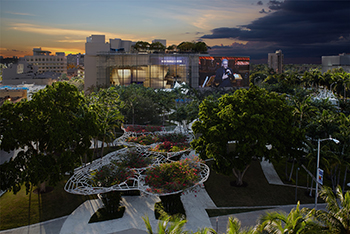
Capitalizing on the warm climes of its home, the New World Symphony is attacking the challenge of audience development by basically turning itself inside out. Opened in 2011, the Frank Gehry designed New World Center is part bricks-andmortar (and lots of glass) and part greenspace—also known as SoundScape—where the orchestra projects free HD videos outside of live performances in its 756-seat concert hall. The images are shown on a 7,000-squarefoot wall adjacent to the building for all the world, including passers-by, to enjoy at no cost.
The orchestra, comprised of recent conservatory graduates known as “fellows,” offers 85 performances a year, ten of which are “Wallcast.” The sound is remarkably good, thanks to an elaborate system of 167 loudspeakers and subwoofers. The average estimated attendance for the 10 simulcasts in 2015-16 was more than 2,000 each.
A new kind of concert-goer
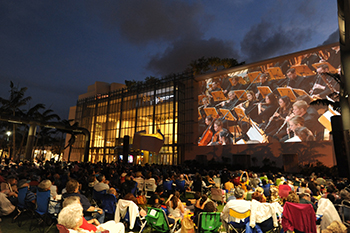
Many of the people at Wallcasts are newcomers to classical music, according to a 2014-15 audience research report by the consulting group WolfBrown. They are generally more reflective of Miami’s ethnic and socioeconomic diversity than conventional NWS audiences, and they are younger. [PHOTO: A live Wallcast of the New World Symphony in action.]
- 34 percent of the Wallcast audience identifies as a person of color, compared to just 12 percent at regular NWS concerts. (For an estimated 60 percent of the Miami Beach population, Spanish is its first language.)
- 30 percent is under age 45; 40 percent is 45 to 65; and 30 percent is over 65.
- Less than 50 percent make $100,000 or more. About 20 percent make $50,000 or less.
- On a given night, 30 percent are attending their first Wallcast, and more than 75 percent have never purchased a ticket to a NWS concert.
“We are bringing new people to this art form,” New World CEO Howard Herring says. “And we’re bringing them with an experience that is social and comfortable and inviting. Yet there is no diminishment of the power of classical music. You get this full-on artistic statement, and you get to sit in your polo shirt and shorts.”
In praise of alternative formats
Alan Brown, co-author of the WolfBrown report, points to the Wallcasts as an example of the new approach to audience building. He calls it “recontextualizing the art in a different setting to free people from negative preconceptions.
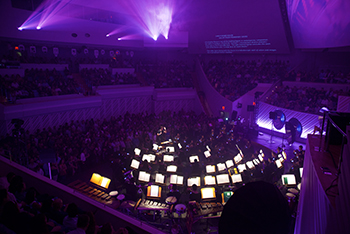
New World accepts that music is a visual experience for people who grew up with MTV and YouTube,” says Brown. NWS favors other off-beat formats as well, such as its late-night Pulse programs that turn the concert hall into a hot nightclub with specially designed lighting effects, a DJ spinning electronica, and orchestra members playing edgy works by the likes of Ligeti and Glass. The hall is dominated by large, curved acoustic “sails” above and around the stage that double as projection surfaces. [PHOTO: The NWS concert hall during a Pulse program.]
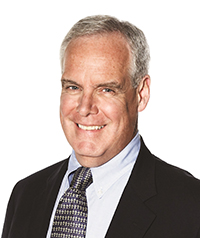
Each of our alternate formats has developed its own audience,” Herring says. “Like a stroke of lightning it hit us that the future is not about a progression toward a traditional format,” adding, however, that there’s no reason to drop the traditional format. “We have a strong audience for that. They love it, we love them. But the future is a progression toward multiple audiences. If you have four or five formats, each with its own audience, you are way better off. More formats, more people, more penetration into the community, more donors. That’s how we see the future.” [PHOTO: Howard Herring, CEO of the New World Symphony.]
It’s not about ticket buyers
In many ways, Herring suggests, directly cultivating ticket sales is beside the point, noting the sponsorship of Wallcasts by Citibank. “People ask what our return on investment is,” he says. “Well, we are building a new audience, and some of them will be ticket buyers, and some of them will not be. But what also happens is that Citi wants access to our audience and our brand, so they are willing to be a sponsor.”
“Tripping over things you love”
Brown especially likes the serendipity of the simulcasts, which attract many passersby to SoundScape, The NWS concert hall during a Pulse program. a short stroll from the boutiques, sidewalk cafes, and art deco hotels in the trendy section of South Beach (aka SoBe). “Michael Tilson Thomas [co-founder and artistic director of NWS] talks about random encounters with music,” he says. “You kind of trip over things you love. When you discover something like a new piece of music, it can move you in powerful ways. But you can’t plan it. So people might show up for a Wallcast and hear, say, something by Berlioz, and say, ‘Oh, my God, what is that?’ Seeds are sown, but they may not sprout for years. And they may not manifest in ticket buying in the short term. But if you don’t do it, you’re damned. You have to plant the seeds.”
Meanwhile, back in the control room…
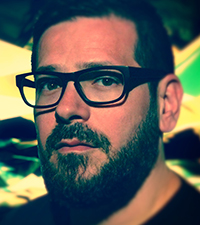
The Wallcasts use at least 10 robotic cameras and are including more and more pre-produced content. Clyde Scott, director of video production, has done about 70 simulcasts in his 13 years with NWS. They’ve grown increasingly complex, from about 300 camera cues in the beginning to about 500 today. People in the park get views of the musicians they would not get in the concert hall. For example, in April’s performance of Dutilleux’s A Whole Distant World, a little camera was attached to the end pin of soloist Anssi Karttunen’s cello, enabling a shot that looked up the fingerboard and into the soloist’s face. [PHOTO: Clyde Scott, director of video production for NWS.]
“I try to engage the audience visually on several levels,” Scott says. “We have cameras fairly high up, looking down 30 feet or so. We have cameras that are almost at eye level with the musicians. And I’m interested in exploring the third level, which is these little cameras that give you a very strange and interesting perspective of the musicians and their instruments.” Over the next few years, NWS hopes to upgrade the simulcast system from HD to 4K video, which will increase image resolution almost fourfold.
From the control booth in the hall, Scott is able to change visuals on the fly to keep in sync with the performance. Imagery of Picasso’s painting Guernica and the rose windows of Chartres Cathedral complemented sections of Honegger’s anti-war Third Symphony. Video created for Cage’s The Seasons was incorporated into a Wallcast. The 2015 premiere of Michael Gordon’s El Sol Caliente featured a film by Bill Morrison.
Costs
Herring acknowledges that labor costs for Wallcasts are “huge,” with 11 people working on sound and video and projections, plus a production crew of 10. The capital investment in infrastructure (cameras, projectors, sound, software, etc.) was $8.5 million, and operating expenses are $10,000 per Wallcast. But the flashy, futuristic nature of the experience is central in appealing to younger audiences. “That’s the secret of it,” Herring says. “The high-tech delivery. We’re in a digital world.”
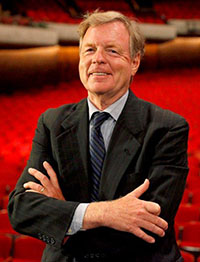
John Fleming writes for Classical Voice North America, Opera News, and other publications. For 22 years, he covered the Florida music scene as performing arts critic of the Tampa Bay Times.
Copyright © 2025, Musical America